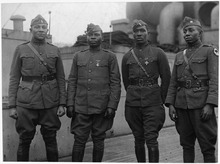American Expeditionary Forces
In addition, Pershing insisted that the American force would not be used merely to fill gaps in the French and British armies, and he resisted European efforts to have U.S. troops deployed as individual replacements in depleted Allied units.The mobilization effort taxed the American military to the limit and required new organizational strategies and command structures to transport great numbers of troops and supplies quickly and efficiently.This served two purposes: familiarizing the Americans with actual battlefield conditions in France, and temporarily reinforcing the British Empire units that were often severely-depleted in numbers, after more than three years of fighting.In fact, the first major operation in World War I to involve US troops concerned individual infantry platoons of the 33rd Division, which were attached to battalions of the Australian Corps for the Battle of Hamel on the 4th of July.Their involvement was voluntary and occurred despite last-minute orders from AEF headquarters, that its troops should not take part in offensive operations led by non-US generals.It had been deliberately dispersed throughout several camps during its stateside training; some of its artillery units were summoned to France before they had completed their courses of instruction, and were never fully equipped until after the Armistice; nearly all its senior white officers scorned the men under their command and repeatedly asked to be transferred.The black enlisted men were frequently diverted from their already attenuated training opportunities in France in the summer of 1918 and put to work as stevedores and common laborers.[16][17] At the beginning, during the spring of 1918, the four battle-ready U.S. divisions were deployed under French and British command to gain combat experience by defending relatively quiet sectors of their lines.By June Americans were arriving in-theater at the rate of 10,000 a day; most of which entered training by British, Canadian and Australian battle-experienced officers and senior non-commissioned ranks.The first offensive action by AEF units serving under non-American command was 1,000 men (four companies from the 33d Division), with the Australian Corps during the Battle of Hamel on 4 July 1918.During the Battle of Saint-Mihiel, Pershing commanded the U.S. First Army, composed of seven divisions and more than 500,000 men, in the largest offensive operation ever undertaken by United States armed forces.By the time the World War I Armistice had suspended all combat on November 11, 1918, the American Expeditionary Forces had evolved into a modern, combat-tested army.[21] The 1918 influenza pandemic in late 1918 raged in the U.S. and France, where it took the lives of more than 25,000 men with the AEF, while another 360,000 became gravely ill. [25] After the Armistice of November 11, 1918 thousands of Americans were sent home and demobilized.








United States ArmyCommand and controlGeneral HeadquartersChaumontFranceWorld War IAllied intervention in the Russian Civil WarWestern FrontBattle of CambraiGerman spring offensiveThird Battle of the AisneSecond Battle of the MarneBattle of SoissonsHundred Days OffensiveBattle of Saint-MihielSecond Battle of the SommeMeuse–Argonne offensiveOccupation of the RhinelandItalian FrontSecond Battle of the Piave RiverBattle of Vittorio VenetoOccupation of the eastern AdriaticNorth Russia interventionBattle of TulgasVaga River frontBattle of Ust-PadengaBattle of ShenkurskBattle of VystavkaBattle of Bolshie OzerkiSiberian interventionBattle of RomanovkaSuchan Valley CampaignBattle of Novo LitovoskayaBattle of PosolskeyaCommander in ChiefJohn J. PershingServices of SupplyJames HarbordArmy Air ServiceMason M. PatrickUnited States Armed ForcesU.S. ArmyFrench ArmyBritish ArmyCanadian ArmyBritish Indian ArmyNew Zealand ArmyAustralian ArmyImperial German ArmyItalian ArmyAustro-Hungarian ArmyAisne OffensiveBattle of Château-ThierryBattle of Belleau WoodMeuse-Argonne OffensiveAmerican Expeditionary Forces on the Western Front (World War I) order of battlePresidentWoodrow WilsonFrederick FunstonAlliedtransport shipsHoboken Port of EmbarkationNew York CityNew JerseyVirginiaBordeauxLa PalliceSaint NazaireDoughboys1st DivisionNancy, FranceLorraineGeorge W. ReadAustralian CorpsBattle of Hamelcanon de 75 modèle 1897canon de 155 C modèle 1917 Schneidercanon de 155mm GPFSPAD XIIINieuport 28Renault FTVerdun26th DivisionNational Guard2nd DivisionU.S. Marines42nd "Rainbow" Division41st DivisionServices of Supply, American Expeditionary ForcesEdwin HubbleCharles G. DawesMilitary Board of Allied Supply366th InfantryAfrican Americanswhitesstevedores92nd Division372nd Infantry Regiments93d DivisionFrench helmetsRemington ArmsM1903 SpringfieldM1917 EnfieldHarlem HellfightersLegion of MeritSergeantHenry JohnsonFrench Croix de guerreMedal of HonorWestern Front (World War I)Battle of CantignyU.S. 1st DivisionBelleau Wood33d DivisionCorporalThomas A. PopeJohn Monashcombined armsMarine CorpsBattle of Château-Thierry (1918)U.S. First ArmydivisionsWorld War I Armistice332d Infantry Regiment339th Infantry RegimentsAmerican Expeditionary Force Siberia